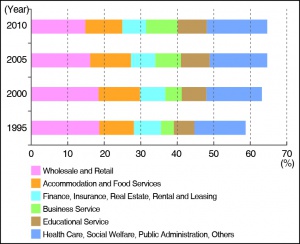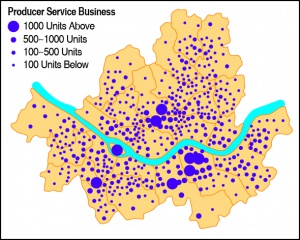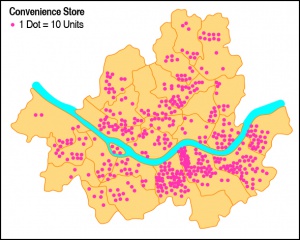GK:3.5.1 각Location of Various Service Industries and Service Industry Policies
Geography of Korea: III. Production and Consumer Space > 5. Service Industry and Tourism> 1) Location of Various Service Industries and Service Industry Policies
1) Location of Various Service Industries and Service Industry Policies
Prior to the 1960s, the vast majority of Korean industries were in the primary sector (i.e., agriculture, forestry, fishing, mining), while the country’s secondary industries (i.e., manufacturing) were insignificant, and tertiary industries (i.e., service industries) were limited to the supply of basic goods and services in a society centered on agriculture. Starting from the 1960s, with the country’s growing industrialization, secondary industries grew significantly, while the ratio of primary sector industries as portion of the national economy saw a sharp decline. The tertiary service industry is in a constant process of advancement and specialization, while the target customer of service industries has also moved beyond the individual consumer to the manufacturer.
Looking at the size of service industry sector by percentage of total work force, it made up 58.6 percent in 1995 and rose somewhat to 64.6 percent of the total workforce by 2010. In terms of the size of the various service industries, the largest are the wholesale and retail industry and the accommodation and food industry, though these are experiencing a gradual reduction while the business service and education industries are seeing growth. Service industries are by their nature distributed in areas with high demand for services and in terms of their value-added in increasing accessibility they can be divided into high value-added services—producer services to support business activities (banking, insurance, real estate), and low valued-added services—consumer services targeting the general consumer (retail and wholesale, food, lodging). In terms of their physical location, producer services collocate with business enterprises and a commanding percentage are located in major metropolitan areas with large working populations and information sources. In order to minimize travel time and increase proximity to their target customers, consumer services tend to be widely dispersed. In the case of Korea, looking at the service industry as a whole, a large percentage of producer services are to be found in the Seoul Capital Region and Busan Metropolitan City, and a high percentage of producer services are found in Seoul, Daejeon, Busan, and metropolitan cities.
Looking in greater detail at the distribution of service sector workers in Seoul, high concentrations of workers in producer services are found in the districts (gu) of Jung-gu and Gangnam-gu, as well as on the island of Yeouido (a banking and financial center located in Seoul’s Han River) and in the Guro Digital Complex. Consumer services workers constitute a large floating population, but their distribution is closely tied to residential areas in parts of the city with high purchasing power.
In terms of Korea’s overall service sector, it is proportionally high in consumer services like wholesale and retail commerce and food and hospitality, while the capacity of its producer services is somewhat vulnerable. Due to the expertise that a service industry in a knowledge-based economy requires, Korean firms will need to grow to the level of foreign companies, whose superior brand recognition and technological strengths have allowed them to occupy the dominant positions in such producer service industries as banking and insurance, consulting, and market research. With economic restructuring, it is important that key high value-added industries, notably those in the producer services sector, become complimentary to enterprises in the industrial manufacturing sector and that the cultural and tourism industries also create added value and jobs in their sectors. In order to strengthen the nation’s creative and imaginative clout through such things as its information and knowledge base, cultural content, and software, the South Korean government has recently turned to emphasizing knowledge-based services and the creative industry as a new paradigm for the national economy. This emphasis on knowledge and creativity as the nation’s future growth engines comes amidst the proliferation of information technologies, such that knowledge, information, and content are now diffused on a global scale. This in turn is increasing the public appetite for recreational activities and interest in cultural value, such as adventure travel and the arts, such that the commercialization of the environment has became the background to new creative endeavors.



